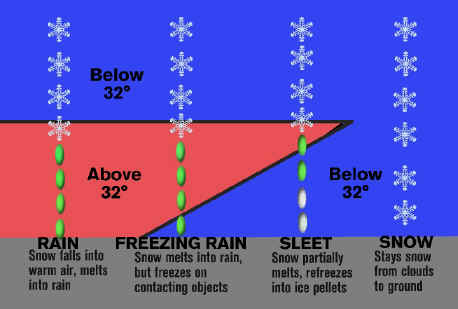What's Up with Winter?
During the winter we see some rain, but sometimes we see other forms of precipitation too. Winter precipitation also includes snow, sleet, and freezing rain. The type of precipitation we get depends on the temperature inside the clouds and the temperature between the clouds and the ground. In clouds that are cold enough for ice crystals to form, we can get snow. Those cold clouds aren’t hard to find. Even in the summer, most of our rain actually starts out high in the clouds as snow. But in winter, the temperature of the air is sometimes cold enough all the way from the clouds to the ground, so snowflakes don’t melt into raindrops. They stay in crystal form and we see snow pile up and schools close.

Look at the figure above. Sometimes there is a layer of air in the clouds that is above freezing, or 32 degrees F. Then closer to the ground the air temperature is once again below freezing. Snowflakes partially melt in the layer of warmer air, but then freeze again in the cold air near the ground. This kind of winter precipitation is called sleet. It bounces when it hits the ground. If snowflakes completely melt in the warmer air, but temperatures are below freezing near the ground, rain may freeze on contact with the ground or the streets. This is called freezing rain, and significant freezing rain is called an ice storm. Ice storms are extremely dangerous because the layer of ice on the streets can cause traffic accidents. Ice can also build up on tree branches and power lines, causing them to break and our lights to go out.
Until spring arrives in March, here’s wishing you a happy and safe winter!
Go here for more on spring
Go here for more on summer
Go here for more on autumn
Go back to Seasons Page
©Copyright 2004 Nick Walker/Small Gate Media